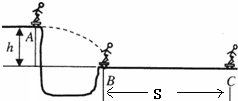问题
问答题
如图所示,某人乘雪橇从A点以2.0m/s的速度飞出,落到B点时的速度为12.0m/s,接着沿水平路面滑至C点停止.人与雪橇的总质量为70kg.(人在空中运动时所受阻力不计,人落地时能量损失也不计).试求:
(1)A点距BC的高度h为多少?
(2)设人与雪橇在BC段所受阻力为自身重力的0.2倍,求BC距离S多大 (g=10m/s2)

答案
(1)从A到B的过程中只有重力做功,机械能守恒,根据机械能守恒定律得:
mgh=
mvB2-1 2
mvB21 2
即70×10×h=
×70×(12)2_ 1 2
×70×(2)21 2
解得:h=7m
(2)人与雪橇在BC段所受阻力f=0.2mg=0.2×70×10=140N
mv2=fs1 2
解得:s=
m=36m
×70×12×121 2 140
答:(1)A点距BC的高度h为7m;
(2)BC距离S为36m.
